
A Rome-bound Ethiopia Airlines flight that diverted to Geneva was hijacked not by terrorists, as was first feared, but by its asylum-seeking co-pilot.
Flight ET-702, a Boeing 767, was in Italian airspace when Hailemedhin Abera Tegegn took control to allow the pilot to use the toilet. After the pilot had left the cockpit, Hailemedhin locked him out and activated a transponder to signal that a hijack situation had arisen.
After Italian fighter jets were scrambled to escort the aircraft out of Italian airspace, the plane landed in Geneva, where the co-pilot turned off the engines, opened the cockpit window and lowered himself to the tarmac with a rope. He then ran towards security officers and identified himself as the hijacker, declared that he was in danger in Ethiopia and requested asylum, according to officials.
A spokesman in Geneva told reporters that none of the 202 passengers and crew on board were even aware an incident had taken place until they were escorted from the plane by Swiss police, adding, “Everybody was safe from beginning to end — no problem.” However, passengers tell of the pilot attempting to break down the cabin door and the hijacker threatening over the PA system to crash the plane unless he stopped.
At a news conference in Addis Ababa, the Ethiopian minister of information, Redwan Hussein, said that Mr. Hailemedhin had no criminal issues that would have made him fear prosecution. “Any political, social reason would not make sense to hijack a plane,” he said, adding, “So far it is known that he was medically sane until otherwise is proven through the investigation.” Mr. Redwan also said that as an Ethiopian citizen, Mr. Hailemedhin was free to leave the country at any time.
A Geneva prosecutor, Olivier Jornot, said the co-pilot would be charged with taking hostages, a crime punishable by up to 20 years in prison. He added that his chances of winning asylum were slim. “Technically, there is no connection between asylum and the fact he committed a crime to come here,” he said, according to Associated Press, adding: “But I think his chances are not very high.”
Flight crew hijacking their own aircraft is not without precedent. In 1953, Mira Slovak, a pilot for Czechoslovak Airlines, locked his co-pilot out of the cockpit shortly after takeoff of a flight to Brno from Prague carrying 25 passengers. Mr. Slovak changed course for West Germany, landed the plane safely in Frankfurt and requested political asylum. Mr. Slovak, now 84, made his way to the United States, where he became a celebrated speedboat racer and a pilot for Continental Airlines.
In 1986, Wang Xijue, a pilot for China Airlines of Taiwan, overpowered his two co-pilots on a cargo flight en route to Bangkok from Taipei, Taiwan. Mr. Wang then diverted the plane, which was not carrying passengers, to Guangzhou, in mainland China, where he defected.










